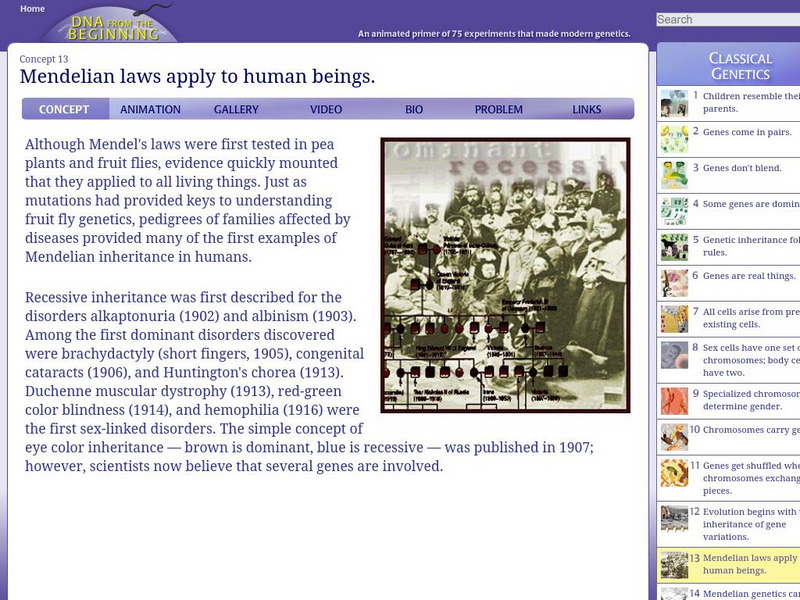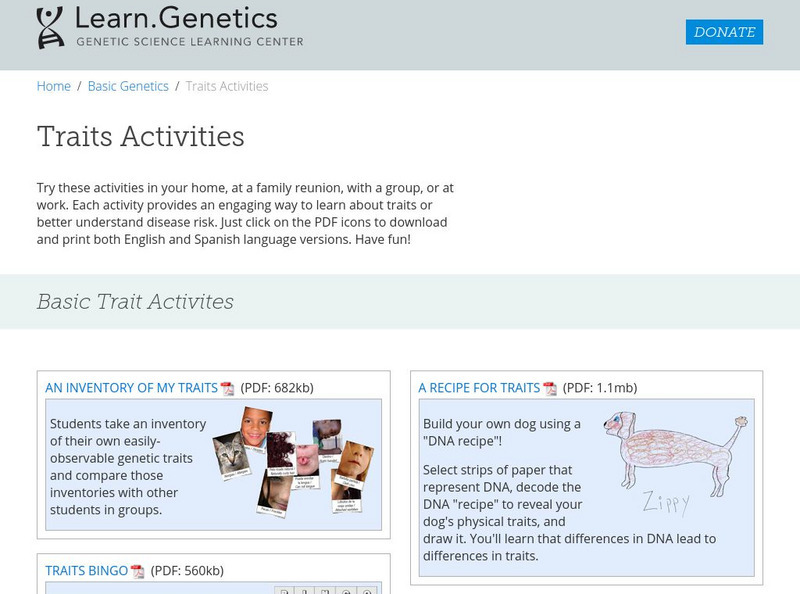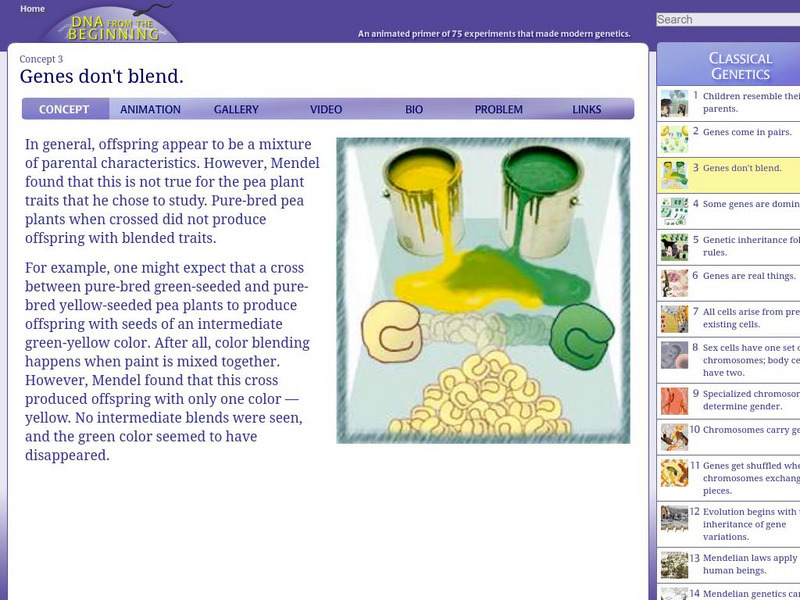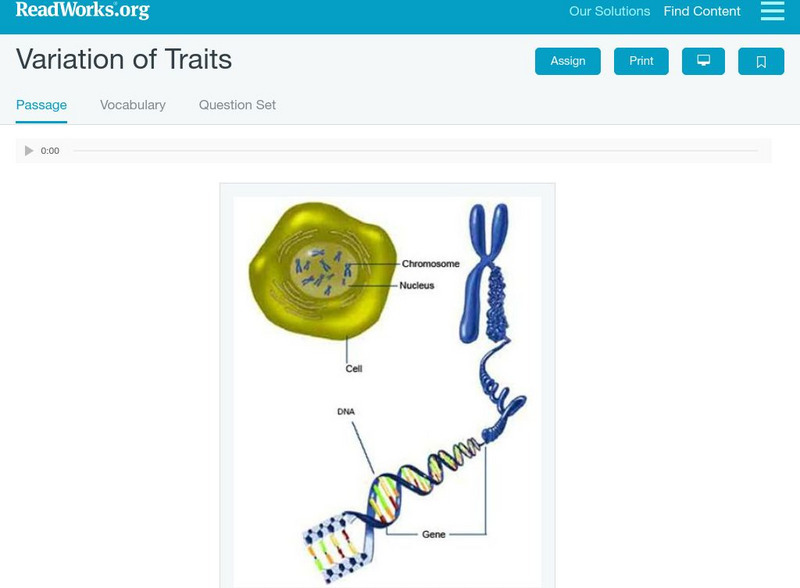Hi, what do you want to do?
Curated OER
Inheritance Patterns in Zorks
In this inheritance patterns worksheet, students create a visual of a Zork using chromosome strips to represent alleles from the father and the mother to determine the traits in the offspring. Students translate the genotype to the...
Curated OER
Trait Variations for Survival
Young learners examine how different traits could give one organism an advantage over another. In groups, they view two different organisms in different environments. To end the lesson, they complete a Venn Diagram on the two organisms...
Curated OER
Next Year's Seeds
Fifth graders explore genetic traits. In this genetic traits lesson, 5th graders discover how traits are passed from parent to offspring while examining plants. Students problem solve real world applications.
Curated OER
Punnett Squares
Fifth graders examine how traits are passed to their offspring using Punnett Squares. They demonstrate how a Punnett Square works by physically moving around boxes taped on the floor, representing the different traits of chicks and...
Curated OER
Reproduction and Heredity
Sixth graders investigate how traits are passed from parents to their offspring. They list things they have in common with family members, read key vocabulary terms, create a poster of shared physical and personality traits, and watch...
Curated OER
Genetic Testing for Disease Susceptibility
Students explore how testing for particular genetic variations can help people to make decisions in lifestyle and health care choices. They analyze a Web-based case study, participate in class discussion, view video segments and...
Curated OER
Gene Puzzles
Pupils explain that in sexually reproducing organisms, such as humans, typically half of the genes come from each parent. They examine a fictional pedigree and determine which gene is responsible for a given trait.
Curated OER
If Your Mom Has Big Feet, Will You Have Them Too?
Young scholars describe and apply the Mendellian principles of genetics, focusing predominantly on dominant and recessive genes. They demonstrate how two parents contribute genes and how those genes appear in their offspring. They...
Cold Spring Harbor Laboratory
Dna From the Beginning: Sex Linked Hemophilia in the Royal Romanov Family
An animated pedigree clearly explains the way hemophilia was inherited in the Romanov family. Interpreting pedigrees and sex-linked crosses should be much easier to understand after going through this tutorial.
University of Utah
University of Utah: Genetic Science Learning Center: Traits Activities
A collection of genetic learning activities provides an engaging way to learn about traits, or better understand disease risk.
Howard Hughes Medical Institute
Hhmi: Biointeractive: Lactase Film With Quiz
Discover why people are lactose intolerant. Understand the genetic traits that allow some people to be lactose tolerant.
Howard Hughes Medical Institute
Hhmi: Biointeractive: Skin Color Interactive Video
Discover the evidence scientists have found to support the idea of evolving skin color. Pigments in the skin may be linked to where our ancestors lived.
Center for Innovation in Engineering and Science Education, Stevens Institute of Technology
Ciese: Human Genetics Project: Is the Dominant Trait Most Prevalent?
Human-Genetics: A Worldwide Search for the Dominant Trait allows you to collect data and share your results with students around the world. Register your class, complete the student survey, participate in discussion boards, and interact...
Cold Spring Harbor Laboratory
Dna From the Beginning: Genes Don't Blend
Learn how Gregor Mendel's study of plants increased scientific knowledge regarding genetic traits.
CPALMS
Florida State University Cpalms: Florida Students: Yes or No to Gmo?
Discover the purpose of genetic engineering in agriculture. Explore the pros and cons of genetic modification.
Famous Scientists
Famous Scientists: Francis Galton
Learn about the life and work of the father of eugenics, and find out how he contributed to the research on human intelligence.
Read Works
Read Works: Variation of Traits
[Free Registration/Login Required] An informational text about the variation of traits built into human DNA. A question sheet is available to help students build skills in reading comprehension.
Bryn Mawr College
Serendip: Dragon Genetics: Understanding Inheritance
Brief text summary of what students learn in the Dragon Genetics II lab along with links to download Student Handouts and Teacher Preparation Notes in PDF and Word formats. Using Popsicle sticks, students experiment with different...
Oak Ridge National Laboratory
Oak Ridge National Laboratory: Behavioral Genetics
A useful introduction from the Oak Ridge National Laboratory on the study of how genetics and behavior are linked. Many useful resource links are included.
American Museum of Natural History
American Museum of Natural History: A Nature and Nurture Walk in Mendel Park
Take a walk in the animated "Mendel Park" to discover which traits are genetic and which are a combination of genetics and upbringing.
Cold Spring Harbor Laboratory
Dolan Dna Learning Center: Inheritance Calculator: Genetic Traits
An interactive Punnett Square inheritance calculator helps students work out patterns of recessive inheritance for a trait, such as straight or peaked hairline.
Alabama Learning Exchange
Alex: Pass It Down
This lesson, Pass It Down, integrates science and math into two consecutive hands-on genetics activities that should be embedded within an existing genetics unit suitable for biology students. The results of each activity will be...
American Museum of Natural History
American Museum of Natural History: O Logy: Stuff to Do: What Makes You You?
Launch an activity that will help you address the nature-versus-nurture debate in terms of your own traits.
Treehut
Suzy's World: Genetics Why Do You Look Like You?
This site explores the role genetics plays in making you look the way that you do. Content includes fun facts and a classroom experiment.


























